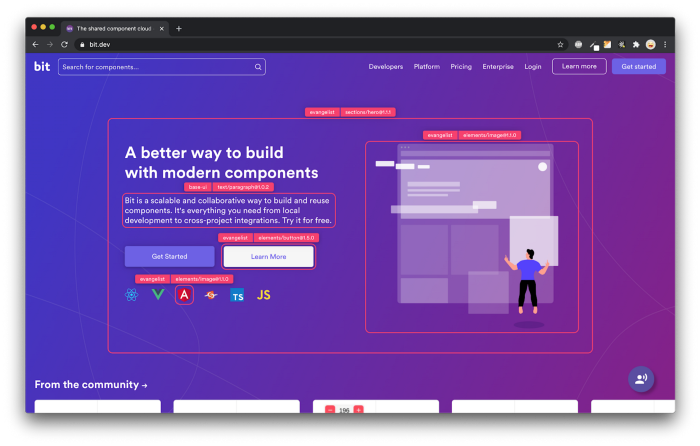This content originally appeared on Bits and Pieces - Medium and was authored by Wesley Grant

When building large web applications, managing code across multiple projects can be a challenge. Each project may have its own dependencies build system and deployment process. This can lead to a lot of duplication, inconsistency, and overhead. To address this, developers have turned to monorepos and workspaces to simplify the management of code.
What is a Monorepo?
A monorepo is a single repository that contains multiple projects. These projects can be related or unrelated, and can use different technologies, languages, or frameworks. By having all of the code in a single repository, it becomes easier to manage dependencies, share code, and enforce consistency across projects.
What are Workspaces?
Workspaces are a way to manage code within a monorepo. Workspaces allow developers to group related projects together and manage them as a single entity. This can be particularly useful when you have shared dependencies or code that is used across multiple projects.
Vite and Flask in a Monorepo
Let’s consider an example where we have a web application that consists of a front-end built using Vite and a back-end API built using Flask. We want to manage these two projects in a single monorepo.
Our file structure might look something like this:
monorepo/
packages/
frontend/
vite.config.js
package.json
index.html
src/
main.js
App.vue
backend/
app.py
requirements.txt
package.json
Here, we have two packages within our monorepo: frontend and backend. The frontend package contains all the files needed to build and run our front-end app using Vite, while the backend package contains all the files needed to build and run our back-end API using Flask.
We can use workspaces to manage these two packages as a single entity within our monorepo. To do this, we need to define our workspaces in our package.json file at the root of our monorepo:
{
"name": "my-monorepo",
"version": "0.1.0",
"private": true,
"workspaces": [
"packages/*"
]
}Here, we’re telling our monorepo that all the directories under the packages directory are part of our workspace.
We can now use the npm or yarn command to install all the dependencies for our workspace:
$ npm install
Or:
$ yarn install
This will install all the dependencies for our front-end and back-end projects.
To start our front-end app, we can use the following command from within the frontend package:
$ npm run dev
Or:
$ yarn dev
This will start the development server and open our front-end app in a web browser.
To start our back-end API, we can use the following command from within the backend package:
$ flask run
This will start the Flask development server and allow us to make requests to our API.
Pros and Cons of Monorepos and Workspaces
There are several benefits and drawbacks to using a monorepo and workspaces.
Pros
- Simplicity: With a monorepo, there’s only one repository to manage, which makes it easier to track changes, enforce consistency, and ensure that everyone is using the same version of dependencies.
- Code sharing: By having all code in a single repository, it’s easier to share code across projects. This can lead to fewer bugs, less duplicated code, and a more consistent user experience.
- Faster builds and tests: With a monorepo, you only need to run builds and tests once, rather than for each project. This can lead to faster build times and faster feedback loops.
- Easier maintenance: With a monorepo, it’s easier to manage dependencies and enforce consistency across projects. This can lead to fewer bugs, less duplicated code, and a more maintainable codebase.
Cons
- Increased complexity: Managing a monorepo can be more complex than managing separate repositories. There can be more dependencies, more files, and more overhead.
- Slower initial setup: Setting up a monorepo can take longer than setting up separate repositories. There may be more configuration and tooling involved.
- Potential for conflicts: With a monorepo, there’s a greater potential for conflicts between projects. This can lead to longer merge times and more difficult conflict resolution.
💡 If you use an open source toolchain such as Bit though, monorepos become infinitely more streamlined. Within a Bit Workspace, all internal dependencies are automatically managed by Bit, with independent testing, documentation, and semver for each. There’s no need to tell npm, pnpm, or yarn which component dependencies need to be installed to, nor if its a dev or prod dependency. Bit dynamically generates package.json files for each, and you can control access for shared code. This guide will show you how.
Bit also enables two-way sharing and collaboration between monorepos, making it easy to reuse code across projects and teams.
Learn more about simplifying a monorepo architecture using Bit:
Monorepos Made Simpler with Bit
Conclusion
Monorepos and workspaces are powerful tools for managing large web applications. They can simplify code management, improve consistency, and reduce duplication. However, they can also introduce complexity and potential conflicts. When considering whether to use a monorepo and workspaces, it’s important to weigh the benefits and drawbacks and consider the specific needs of your project.
Develop components and manage packages in any repo architecture easily with Bit

Bit’s open-source tool help 250,000+ devs to build apps with components.
Turn any UI, feature, or page into a reusable component — and share it across your applications. It’s easier to collaborate and build faster.
Split apps into components to make app development easier, and enjoy the best experience for the workflows you want:
→ Micro-Frontends
→ Design System
→ Code-Sharing and reuse
→ Monorepo
Learn more:
- How We Build Micro Frontends
- How we Build a Component Design System
- How to reuse React components across your projects
- 5 Ways to Build a React Monorepo
- How to Create a Composable React App with Bit
Managing Large Web Applications with Monorepos and Workspaces was originally published in Bits and Pieces on Medium, where people are continuing the conversation by highlighting and responding to this story.
This content originally appeared on Bits and Pieces - Medium and was authored by Wesley Grant
Wesley Grant | Sciencx (2023-03-28T03:43:03+00:00) Managing Large Web Applications with Monorepos and Workspaces. Retrieved from https://www.scien.cx/2023/03/28/managing-large-web-applications-with-monorepos-and-workspaces/
Please log in to upload a file.
There are no updates yet.
Click the Upload button above to add an update.
